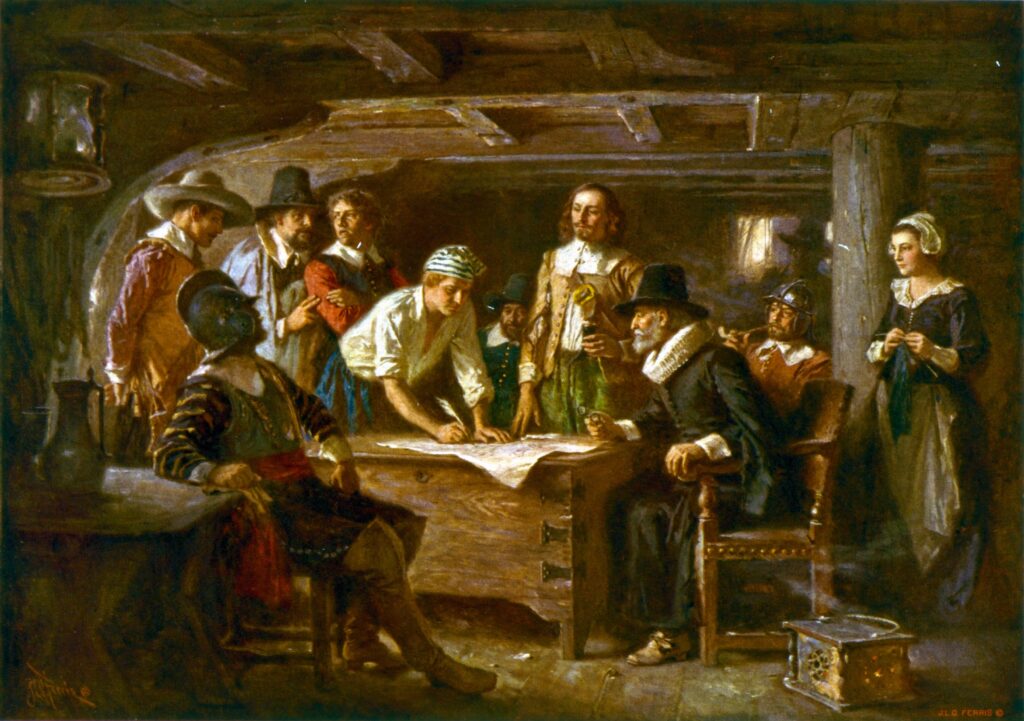
Before the Pilgrims could set foot on Plymouth Rock and eventually celebrate that first Thanksgiving a year later in 1621, there was some serious paperwork and crisis management to deal with.
This is the story of the Mayflower Compact, that ground-breaking social contract that was drawn up in a moment of crisis, ultimately paving the way for self-governance in the New World.
In this article, we will :
share with you the fascinating tale of its conception,
make connections between the document and legal practice today
review relevant legal vocabulary.
The Voyage That Went Off-Course
In September 1620, 102 passengers set sail from England aboard the Mayflower, aiming for the northern reaches of Virginia. They had hope, determination, and a royal charter that granted them the right to settle and govern a colony there.
But the Atlantic had other plans. High winds and rough seas blew the Mayflower far to the north, landing the passengers at Cape Cod.
Uncharted Territory and a Legal Vacuum
This was problematic because the charter didn’t apply there. Legally, the settlers were in uncharted territory, without a government, without courts, and without any recognized authority.
To make matters more complex, not all of the passengers on the ship were Pilgrims. Nearly half were “strangers”, in other words, tradesmen, adventurers, and merchants hoping for work and a fresh start in the colony.
Some of these passengers became restless and argued that, since the charter had no legal force in this area, no one could command obedience. If the settlers couldn’t agree on rules and authority, survival itself might be at risk. They needed law and order fast.
The Mayflower Compact to the Rescue
So, before stepping onto dry land, the leaders drafted the Mayflower Compact. It was a stopgap legal measure, a self-created charter to fill the gap until they could get proper authorization from England. In it, the 41 male signers:
Covenanted together to form a “civil body politic”
Agreed to make just and equal laws for the good of the colony
Promised submission and obedience to those laws
In modern terms, it was like forming a startup without investors but with plenty of risk!
The Compact: A Bridge Between Contract and Constitutional Law
Social Contract: At its heart, the Compact was a mutual agreement among the settlers. They “covenanted and combined themselves together” to create a community and promised to obey the laws they would make for their own good. That sounds like the principle of contract law:
There are parties (the signers)
There is consideration (mutual protection and governance)
There is consent (they voluntarily agree)
And there is an obligation (to obey their own laws)
So, in a broad sense, the Compact can be viewed as a political contract—a collective agreement forming the basis of governance.
Legal parallel: This anticipates the philosophical idea of the social contract, later developed by Hobbes, Locke, and Rousseau—the notion that governments derive authority from the consent of the governed.
Proto-Constitution: However, the Compact also functions as an early constitutional document. It establishes:
A “civil body politic” (a governing entity)
The power to make laws and offices
The principle of majority rule and equality under those laws
Unlike a simple contract, the Compact created a political framework that outlived the individuals who signed it. It wasn’t just a private agreement; it was the foundation for a public legal order—the governance of Plymouth Colony.
Legal parallel:
It’s a forerunner of later American constitutional documents like:
The Fundamental Orders of Connecticut (1639) – often called the first written constitution.
The U.S. Constitution (1787) – which formalized the same principles of self-government and rule of laws.
Indeed, the Mayflower Compact is best described as: a proto-constitutional social contract—part political covenant, part legal agreement.
Contemporary Legal Connections and Terms
Self-Governance and Social Contract
The Compact reflects a form of voluntary social contract, where settlers agreed to abide by rules for the common good. In modern law, collective agreements serve the same purpose, defining obligations, rights, and dispute resolution mechanisms in labor or organizational contexts.
Key legal terms: ratification, mutual consent, binding, enforceable, arbitration
Jurisdictional Ambiguity
By landing outside the Virginia Company’s jurisdiction, the settlers had to create a legal framework from scratch. Today, lawyers encounter similar situations in territories with ambiguous sovereignty, refugee camps, or post-conflict zones, where de facto governance fills gaps in formal law.
Key legal terms: ambiguous sovereignty, de facto governance
Necessity and Emergency Powers
The Compact also exemplifies governance under necessity. The settlers exercised provisional authority to maintain safety and order. Modern law uses similar mechanisms to allow governments or organizations to act decisively during crises, while still ensuring oversight and accountability.
Key legal terms: provisional authority, emergency powers, necessity, extraordinary circumstances, oversight and accountability, de facto authority
Force Majeure and Unforeseen Events
The storm also parallels modern concepts of force majeure, where unforeseen circumstances prevent contractual performance. Today, contracts frequently include clauses excusing obligations due to natural disasters, pandemics, or other extraordinary events.
Key legal terms: force majeure, frustration of contract, impossibility, discharge, extraordinary circumstances
Conclusion
That first Thanksgiving, the Pilgrims held a feast to celebrate their surviving the winter in the New World thanks to the generosity of the Natives. But none of this would have been possible without the Compact—illustrating that when people are determined to live together peacefully, a 200-word document, written and signed by the people, can make this dream a reality. That’s something to be grateful for, don’t you think?
The Mayflower Compact, 1620
Jean Leon Gerome Ferris (1863–1930)
Oil on canvas, from the series The Pageant of a Nation.
Image courtesy of the Prints and Photographs Division, Library of Congress (Reproduction No. LC-USZC4-7155).
